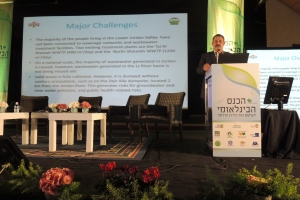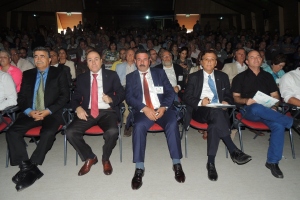20-21/10/2014
Israel
Jordan Valley Authority delegation headed by his Excellency Secretary General Mr. Saed Abu Hamour and representatives from EcoPeace Middle East participated in a two days conference labeled “International Conference on the Rehabilitation of the Lower Jordan River (Phase A) and The Development of the Border Region Between the State of Israel and the Hashemite Kingdom of Jordan along the Jordan River” that took place in Israel from the 20th until the 21st of October.
The conference was also attended by close to 500 participants from various sectors including academia, municipal bodies, industry, and other representatives from the civil society renowned in the fields of river restoration and water management. Most notably, the conference was attended by representative from the Israeli government in the persons of Mr. Silvan Shalom Minister of National Infrastructure, Energy and Water resources, Minister for the Development of the Negev and Galilee and Minister of Regional Development, and Mr. Amir Peretz Minister of Environmental Protection.
The conference included various sessions and presentations concerning the Master Plan for the rehabilitation of the Lower Jordan River and its surroundings, dilemmas of regional planning while maintaining and nurturing nature, and possible solutions for these dilemmas among many others.
His Excellency Mr. Abu Hamour, presented about the Jordanian Jordan Valley and the importance of it rehabilitation leading to development. In his speech he stated that the three neighboring countries of Jordan, Israel, and Syria are responsible for the rivers degradation once flowing with a billion four hundred mcm per year before diversion of its sources. The rehabilitation of the river will entail attracting investment and tourism to the valley leading to its anticipated revival. He added that it is only through cooperation that this can be achieved. His Excellency shared the specifics of the Jordanian Master Plan as introduced to the government by EcoPeace Middle East.
On his turn, Minister of Environmental Protection Amir Peretz spoke about the River Restoration as a key for Cross-border Environmental Cooperation. He said “we have set for ourselves an iron rule: the war against terrorist organizations and extremists, along with the construction of a bridge infrastructure for peace with moderate Islam and moderate Arab states, with the moderate world and moderate Palestinians.” He added “this is the basis of our existence and our security in the Middle East. This bridge can be built and we should start building it now. Environmental issues can serve as the foundation for regional cooperation and reducing disparities.” He elaborated that cross-border environmental pollution does not stop at the border; an example is the deadly virus spreading in Africa and threatens the entire world. Winds and rivers flow and do not stop at the border.” A case in point is the Jordan River; holy in Abarahamic religions. He added that the river presents enormous potential not only for environmental development but for tourism as well.
During the session Vision of Communities: My Jordan Valley, Ms. Yana Abu Taleb, Assistant Director for Projects and International Affairs at EcoPeace Middle East presented the organizations vision for a rehabilitated river. In this regard, EcoPeace Middle took notice of the current degradation of the Lower Jordan River and together with international consortium partners the Stockholm International Water lnstitute (SlWl) and Global Nature Fund (GNF) undertook the development and publication of the first ever regional master plan for the Lower Jordan River Basin.
Ms. Abu Taleb explained that the Lower Jordan Valley is divided between Jordanians, Israelis, and Palestinians, the latter denied access to the Jordan and receiving no water directly from the river. The root of the problem is conflict, she added.
She elaborated that the countries of Israel, Jordan, Syria, and Lebanon sharing the basin race to capture the greatest possible share of the Jordan’s water instead of seeing the valley as a single, transboundary watershed leading to its degradation.
EcoPeace Middle East mains strategic pillars for the rehabilitation of the Lower Jordan River basin as mentioned in the Master Plan are based on balancing the needs of people and nature, cross-border water justice which means that the Palestinian riparian rights and fair share of the benefits of an accessible and rehabilitated river are respected; a central component of the master planning process. Finally, encouraging community based activism to promote livelihood benefits for community residents. She concluded.
It is worth mentioning that EcoPeace Middle East will present a regional master plan for the Lower Jordan River Master Plan funded by the European Union in its upcoming conference on Sustainable Development in the Jordan Valley in November. The master plan incorporates national Jordanian, Israeli, Palestinian master plans into a single cohesive trans- boundary master plan that could be advanced in full or in part by decision makers both unilaterally at the national level, and at the regional level.
The required interventions are intended to improve the environmental and economic conditions of the Jordan Valley and its inhabitants. It will be used by the consortium partners as an advocacy tool with national and international stakeholders for the purpose of increasing the political will for the adaptation in full or in part of the study’s recommendations by national authorities in the region.
The Master Plan is built on EcoPeace Middle East’s vision of a rehabilitated river, managed jointly, shared equitably and accessible to all.
For an overview of the Regional Master Plan introduced, click on the link
http://foeme.org/uploads/RHDHV_Presentation_17_3_13.pdf
For a draft Regional NGO Master Plan for the Lower Jordan River Valley Baseline Report, click on the link
http://foeme.org/uploads/FoEME_Baseline_Report_vs5_L.pdf
This post is contributed by Samar M. Salma, EcoPeace Middle East Media Officer/ Projects Coordinator at the Amman Office.
